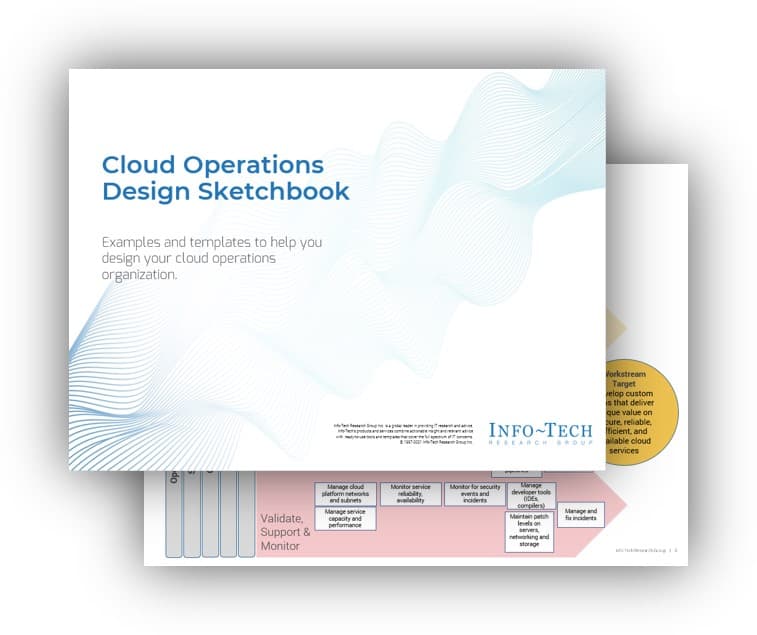- Traditional IT capabilities, activities, organizational structures, and culture need to adjust to leverage the value of cloud, optimize spend, and manage risk.
- Different stakeholders across previously separate teams rely on one another more than ever, but rules of engagement do not yet exist.
Our Advice
Critical Insight
Define your target cloud operations state first, then plan how to get there. If you begin by trying to reconstruct on-prem operations in the cloud, you will build an operations model that is the worst of both worlds.
Impact and Result
- Assess your key workflows’ maturity for life in the cloud and evaluate your readiness and need for new ways of working
- Identify the work that must be done to deliver value in cloud services
- Design your cloud operations framework and communicate it clearly and succinctly to secure buy-in
Member Testimonials
After each Info-Tech experience, we ask our members to quantify the real-time savings, monetary impact, and project improvements our research helped them achieve. See our top member experiences for this blueprint and what our clients have to say.
9.3/10
Overall Impact
$53,650
Average $ Saved
35
Average Days Saved
Client
Experience
Impact
$ Saved
Days Saved
University of Ottawa
Guided Implementation
10/10
N/A
5
Oklahoma Office of Management and Enterprise Services
Workshop
8/10
N/A
N/A
We provided Jeremy with a less-than-ideal situation and he continued to provide the best value he could. I greatly appreciated his work and apologi... Read More
Ledcor Industries Inc.
Workshop
9/10
$27,500
18
Enjoyed the collaboration and reconnecting the dots with the different business areas
The Alberta Teachers Association
Workshop
9/10
$50,000
20
Nabeel was excellent and struck a great balance in getting to know our small team in the time we had and being very productive while we attended th... Read More
State of Michigan
Workshop
10/10
$137K
110
Franklly the last two questions in this survey. It's very difficult to come up with the "Time Saved" estimate due internal obsticles that must be ... Read More
Financial Transactions and Reports Analysis Centre of Canada
Workshop
10/10
N/A
20
Very good workshop. Jeremy provided a lot of valuable information and got us working well together.
Workshop: Design Your Cloud Operations
Workshops offer an easy way to accelerate your project. If you are unable to do the project yourself, and a Guided Implementation isn't enough, we offer low-cost delivery of our project workshops. We take you through every phase of your project and ensure that you have a roadmap in place to complete your project successfully.
Module 1: Establish context
The Purpose
Establish context
Key Benefits Achieved
Alignment on target state
Activities
Outputs
Assess current cloud maturity and areas in need of improvement.
Identify the drivers for organizational redesign.
Review cloud objectives and obstacles.
Develop organization design principles.
- Cloud Maturity Assessment
- Cloud Challenges and Objectives
Module 2: Establish context (continued)
The Purpose
Establish context
Key Benefits Achieved
Understanding of cloud workstreams
Activities
Outputs
Evaluate new ways of working.
Develop a workstream target statement.
Identify cloud work.
- Workstream target statement
- Cloud operations workflow diagrams.
Module 3: Design the organization and communicate change
The Purpose
Design the organization
Key Benefits Achieved
Visualization of the cloud operations future state
Activities
Outputs
Design a future-state cloud operations diagram.
Create a current-state cloud operations diagram.
Define success indicators.
- Future and current state cloud operations diagrams
Module 4: Design the organization and communicate change (continued)
The Purpose
Communicate the changes
Key Benefits Achieved
Alignment and buy-in from stakeholders
Activities
Outputs
Create a roadmap
- Roadmap
Create a communication plan
- Communication plan












 Create a Service Management and IT Operations Strategy
Create a Service Management and IT Operations Strategy
 Optimize the IT Operations Center
Optimize the IT Operations Center
 Improve Incident and Problem Management
Improve Incident and Problem Management
 Optimize IT Change Management
Optimize IT Change Management
 Harness Configuration Management Superpowers
Harness Configuration Management Superpowers
 Develop an IT Infrastructure Services Playbook
Develop an IT Infrastructure Services Playbook
 Develop Infrastructure & Operations Policies and Procedures
Develop Infrastructure & Operations Policies and Procedures
 Stabilize Release and Deployment Management
Stabilize Release and Deployment Management
 Deploy AIOps to Improve IT Operations
Deploy AIOps to Improve IT Operations
 Create Visual SOP Documents that Drive Process Optimization, Not Just Peace of Mind
Create Visual SOP Documents that Drive Process Optimization, Not Just Peace of Mind
 Improve IT-Business Alignment Through an Internal SLA
Improve IT-Business Alignment Through an Internal SLA
 Implement Infrastructure Shared Services
Implement Infrastructure Shared Services
 Next-Generation InfraOps
Next-Generation InfraOps
 M&A Runbook for Infrastructure and Operations
M&A Runbook for Infrastructure and Operations
 Reduce Manual Repetitive Work With IT Automation
Reduce Manual Repetitive Work With IT Automation
 Take Control of Cloud Costs on AWS
Take Control of Cloud Costs on AWS
 Take Control of Cloud Costs on Microsoft Azure
Take Control of Cloud Costs on Microsoft Azure
 Govern Shared Services
Govern Shared Services
 Responsibly Resume IT Operations in the Office
Responsibly Resume IT Operations in the Office
 Take Control of Infrastructure and Operations Metrics
Take Control of Infrastructure and Operations Metrics
 Engineer Your Event Management Process
Engineer Your Event Management Process
 Design Your Cloud Operations
Design Your Cloud Operations
 Build a Continual Improvement Program
Build a Continual Improvement Program
 Align Projects With the IT Change Lifecycle
Align Projects With the IT Change Lifecycle
 Prepare for Microsoft 365 Copilot
Prepare for Microsoft 365 Copilot
 Build Seamless IT Operations With Automation
Build Seamless IT Operations With Automation




